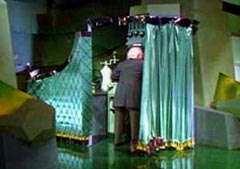I sometimes go to Mass with my wife for companionship, and today, I was certainly glad I did. Before I get into the reason why, some theology.
Catholics of course believe in something they call the “Real Presence,” which is the belief that the bread and wine are the actual body and blood of Jesus. It’s based on an Aristotelian concept of accident and essence — what a thing looks like and what it really is. So the Catholic explanation of why it still looks suspiciously like bread and wine is that the outward appearance has remained, but the essential reality has changed.
This is why there’s all the genuflection in churches and especially before monstrances, because if that really is God in the flesh flour, then it only makes sense to bow.
This also goes a long way in explaining the controversy about how a parishioner can take the host: standing, kneeling, on the tongue, on the palm of the hand. I think the variety is strictly American. In Poland, the issue is vastly simplified: stand or kneel. There’s no way a priest will give it to your hand in Poland.
“Real Presence” also explains why some might be a little uneasy with the idea of anyone other than a priest handing out the host. In the States, members of the congregation hand out the blood and wine (though the priest has consecrated it and all that). Again, this is probably a completely American thing.
All this is to explain the significance of why I’ve always wondered what would happen if someone tripped and — whoosh — there’s God, all over the floor.
At this morning’s Mass, my question was answered.
An elderly woman, serving as Eucharistic minister, was heading back up to the altar (and so her chalices were probably almost empty) when suddenly there was a stumble, shuffle, and crash. I saw the whole thing out of the corner of my eye, and I immediately directed all my attention there — as did everyone else in the basilica.
The priest kept right ongoing, but not many people were giving him their undivided attention. Everyone was looking at the aisle, watching the lady pick up the hosts as another Eucharistic minister helped her. Then a deacon came with a cloth that had been dampened, I’m assuming with holy water, and wiped the spot.
The woman was obviously quite shaken. She said some words to the priest, and he sympathetically comforted her. Returning to her seat, she muttered something to her husband, and that was that.
It highlights how atypical Catholicism is in modern culture, where all sense of the sacred has disappeared. “And so much the better” many of us would add, but sacredness fosters a certain respect that I’m not sure you can get any other way. It’s simplistic to explain it, “Well of course it’s respect — born out of fear, a terror that some deity will toast you.” There’s certainly an element of truth in that.
Communism tried to foster some sense of the sacred — the working masses were the vessels for salvation. The working man is the communist messiah. Marches, songs, flag-waving, speeches — all these things to foster a sense of the sacred in the people. Yet it didn’t work. My wife grew up in that culture, and it was all a joke for everyone. Why?
 It lacked mystery.
It lacked mystery.
Without mystery, without an element of the unknown and inexplicable, nothing can be sacred. Indeed, sacredness could be defined as a sense of mystery about something thought to be of divine origin. If you see the little old man putting together the wizard show, hanging the curtains, preparing the control panel, it is only through an act of supreme wishful thinking that you can put your faith in the Wizard.
0 Comments